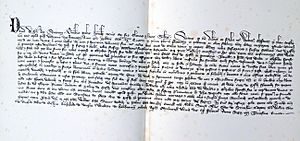Elizabeth Bruce facts for kids
Elizabeth Bruce was a daughter of King Robert the Bruce, a famous Scottish king. She married Sir Walter Oliphant of Aberdalgie and Dupplin.
Contents
Was Elizabeth Really a Princess?
For a long time, some people wondered if Elizabeth Bruce was truly a daughter of King Robert the Bruce. A historian named Sir David Dalrymple wrote a book where he questioned if she even existed! He hadn't seen her name in many old records.
However, there was no real proof that she wasn't King Robert's daughter. The doubts came from two main reasons. First, some important old histories didn't mention her. Second, Sir David Dalrymple hadn't seen the official documents that named her.
To clear up any confusion, there were many royal documents, called charters, that proved Elizabeth was indeed a princess. These charters were signed by her brother, King David II. They often described Elizabeth as "my beloved sister" or "our beloved sister." These documents were about lands and castles like Gask, Dupplin, and Kellie. Sir Walter Oliphant and Elizabeth Bruce got these charters in 1364. They were reconfirming that they owned these lands from her brother, King David II.
When Sir David Dalrymple was finally shown one of these charters, he promised to correct his books. Sadly, he passed away in 1792 before he could make the changes. Because of this, the mistake was repeated in other books for many years.
Elizabeth's Life Story
We don't know exactly when Elizabeth Bruce was born. Her mother, Elizabeth de Burgh, died in 1327. It's thought that Elizabeth Bruce was born around that time.
We do know for sure that Elizabeth was alive in 1364. That's when her brother, King David II, officially confirmed the lands she and her husband owned. Her exact death date is also unknown.
Since she was likely born around 1327, it's believed she was named after her mother, Elizabeth de Burgh.
A Special Burial Place
Elizabeth Bruce and Sir Walter Oliphant paid for a beautiful stone cover for the Oliphant family tomb. This cover was made from special marble from a place called Tournai. It's one of the most impressive carved monuments in Scotland.
The design on the stone shows a knight in armor. This armor style tells us the slab was made around 1360. The knight shown is Sir William Oliphant, who was Walter's father. Sir William had died much earlier, in 1329. The most likely reason for creating such a grand tomb cover was to make a burial place fit for a princess like Elizabeth. Elizabeth and her husband were eventually buried there.
Line to the Throne
Elizabeth Bruce was probably born just before her mother died in 1327. Her father, King Robert the Bruce, died two years later in 1329. These big events likely overshadowed her birth and early childhood.
Being born later might explain why she lived longer than most of her brothers and sisters. As the youngest child of King Robert the Bruce and Elizabeth de Burgh, Elizabeth Bruce would have been sixth in line to become the ruler of Scotland.
Kellie Castle Connection
In 1360, Elizabeth Bruce and Sir Walter Oliphant received the estate and lands of Kellie in Fife. These lands were given to them by Helena Maxwell.
New Noble Titles
During the time Elizabeth Bruce and Sir Walter Oliphant were married, new noble titles started to appear in their family. These included Lord Oliphant, Lord Aberdalgie, and Lord Dupplin. We don't know exactly why these titles were created. However, it was likely because of their royal connection to King Robert the Bruce. In a similar way, King David II raised many of Sir Walter and Elizabeth's lands to the status of baronies, which gave them special rights.


